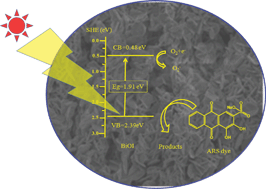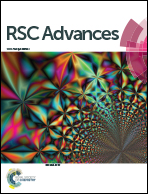Electrospun BiOI nano/microtectonic plate-like structure synthesis and UV-light assisted photodegradation of ARS dye†
Abstract
BiOI electrospun nanofibers were prepared by using PAN as a supporting polymer. Subsequent annealing at 500 °C for 5 h, with a ramp rate of about 5 °C min−1 in air, breaks the nanofibers down to tectonic plate-like nano/microstructures. The surface physical and chemical structural changes were then further characterized by FE-SEM, TEM, XRD and XPS. The results reveal that the morphology and crystallite size of BiOI vary strongly depending on the precursor concentration used in the synthesis method. These nanostructures were later employed for photocatalytic degradation of a synthetic textile dye, Alizarin Red S (ARS). The photocatalytic efficiencies were found to be about 93.34% after 100 min of UV-light (340 nm) illumination. Photocatalytic activity (PCA) performance depends on morphology and band alignment. All the compositions follow first order pseudo-kinetics, which was found to be 0.1197 min−1 for a doping concentration of 3%. The enhancement in photodegradation could be possibly by photocatalysis and a photosensitization phenomenon. This has been explained based on the band edge position.


 Please wait while we load your content...
Please wait while we load your content...